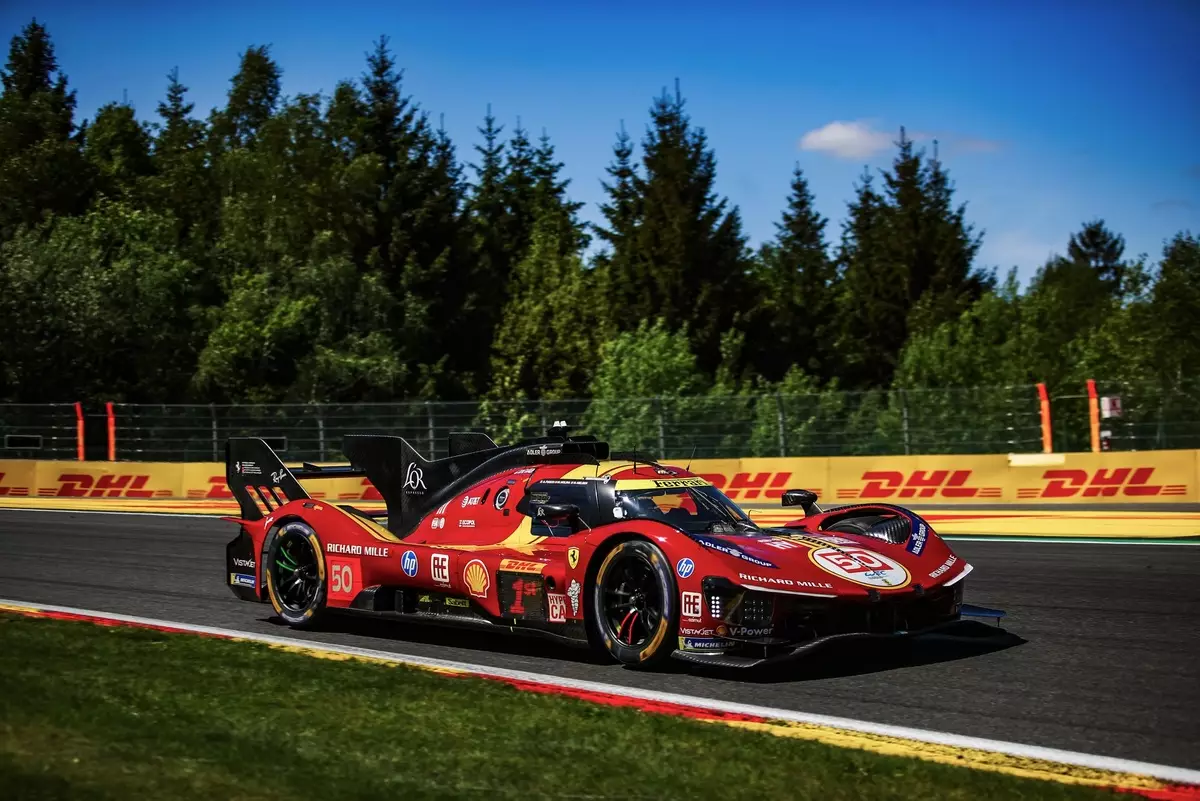In an electrifying display during the qualifying sessions for the 2025 Spa 6 Hours, Ferrari once again showcased its supremacy in the World Endurance Championship (WEC). With Antonio Fuoco behind the wheel of the #50 Ferrari 499P Le Mans Hypercar, the Italian team secured a remarkable sweep of the top three positions, signaling their continued dominance in the series. Fuoco’s pole position, achieved with a time of 1m59.664s during the exhilarating 12-minute Hyperpole session, underscored the Ferrari’s engineering brilliance and strategic prowess.
Robert Kubica, in a customer entry managed by AF Corse, clinched second place with a commendable effort of 1m59.964s. His performance highlighted the competitiveness of Ferrari’s customer teams, which continue to challenge their factory counterparts. Completing the lockout of the top three spots, Antonio Giovinazzi placed third with a time of 2m00.201s in the #51 factory car, which earlier this season had already celebrated pole positions in both Qatar and Imola. Such results not only bolster Ferrari’s reputation but also create a narrative of rivalry within their own ranks, a dynamic that adds an intriguing layer to the competition.
Facing the Competition: Challenges for Rivals
While Ferrari basked in the spotlight, other manufacturers faced considerable challenges. The closest contender, the #94 Peugeot 9X8 driven by Stoffel Vandoorne, lagged six tenths off Ferrari’s blistering pace, finishing with a time of 2m02.218s. This gap raised questions about Peugeot’s current competitiveness in the WEC, especially in light of the historic performance by Ferrari. Just behind them, Alex Lynn in the Jota team’s Cadillac V-Series.R LMDh narrowly missed out, clocking in at 2m02.246s. The discrepancies in performance metrics between the leading Ferraris and their competition are stark and indicate a need for further development from rival teams.
Mick Schumacher, now steering the Alpine A424 LMDh, showcased promise by finishing sixth. His timing of 2m00.368s added to the contention, putting pressure on competitors such as Jean-Eric Vergne in his Peugeot, who contested fiercely for positions but ultimately fell short of the top spots. BMW’s showings mirrored earlier seasons as they placed eighth, again demonstrating a need for improvement relative to Ferrari’s commanding presence.
The Struggles of the Champions: Toyota and Porsche’s Setbacks
A noteworthy disappointment this season has been the struggle of the defending champions, Toyota and Porsche, who both found themselves failing to qualify for the Hyperpole session. Positioned in the lower rankings, with Porsche’s vehicles crossing the finish line at 12th and 13th, it was clear that they did not possess the pace necessary to compete with the frontrunners. The factory Porsche Penske Motorsport 963 LMDhs, both nearly 1.5 seconds off the top time, experienced what appeared to be a critical setback in their competitiveness.
Toyota’s situation was similarly bleak, as their GR010 HYBRID LMHs staggered into 15th and 16th places. The team’s lack of performance stemmed in part from adjustments made under the Balance of Performance rules, which stripped them of 20 kW (25 bhp) since Imola. The ultrafast tempo set by Ferrari highlights the uphill battle that both teams face as they endeavor to reclaim their spots at the top.
The Rising Stars: Lexus and Other Notable Performances
Amidst these developments, Lexus marked a significant achievement by claiming a maiden LMGT3 class victory. Driver Finn Gehrsitz propelled the Auto Sport Promotion RC F GT3 to the forefront with a notably swift lap of 2m17.732s, edging out Eduardo Barrichello in the Spirit of Leman Aston Martin, who, despite a late surge, fell just short at 2m18.008s. This performance not only spotlighted Lexus but also highlighted the unpredictability of the racing landscape, where up-and-coming teams can break through established hierarchies.
In further competitive action, Ford demonstrated formidable skill, securing both the third and fourth positions with their Proton Competition Mustang GT3s. Ben Tuck’s clocked in at 2m18.016s, and Giammarco Levorato completed the duo with a competitive time of 2m18.229s. Such performances hinted at a shifting dynamic in endurance racing where traditional powerhouses may need to reassess their strategies in the face of emerging talent.
This event at Spa activates anticipation for the race itself; all eyes will be on whether Ferrari can translate this qualifying dominance into race-time success, while its competitors strive for upset victories in the thrilling world of endurance racing.

